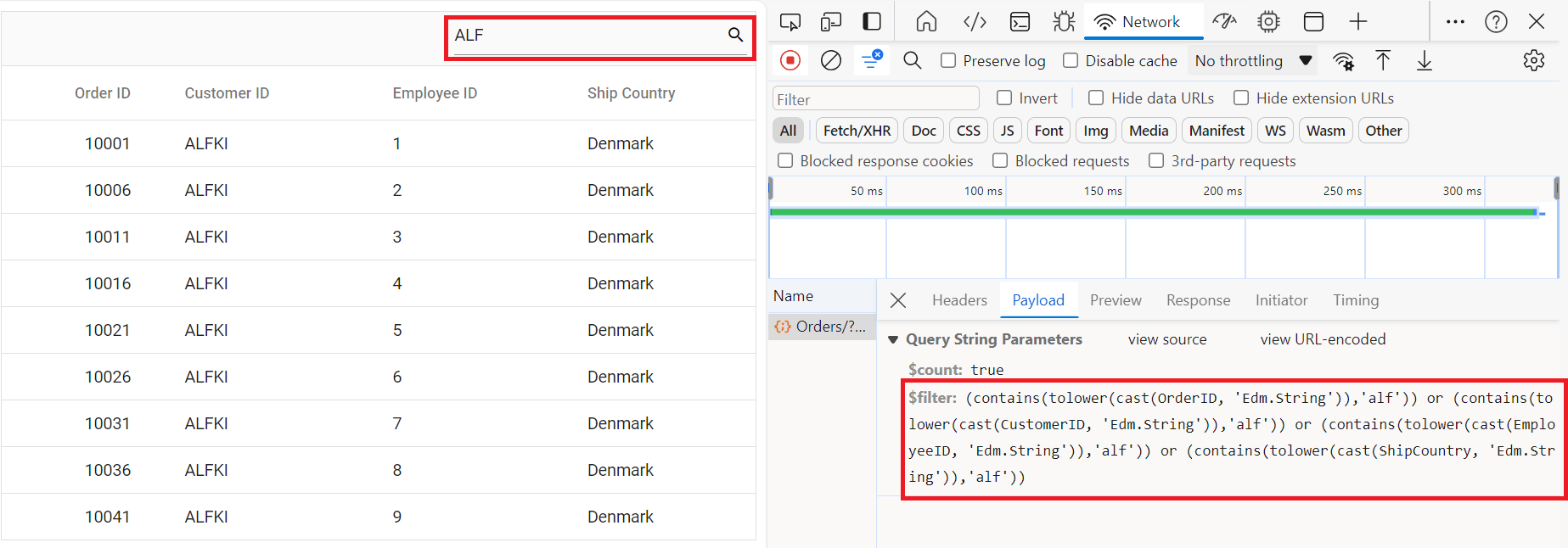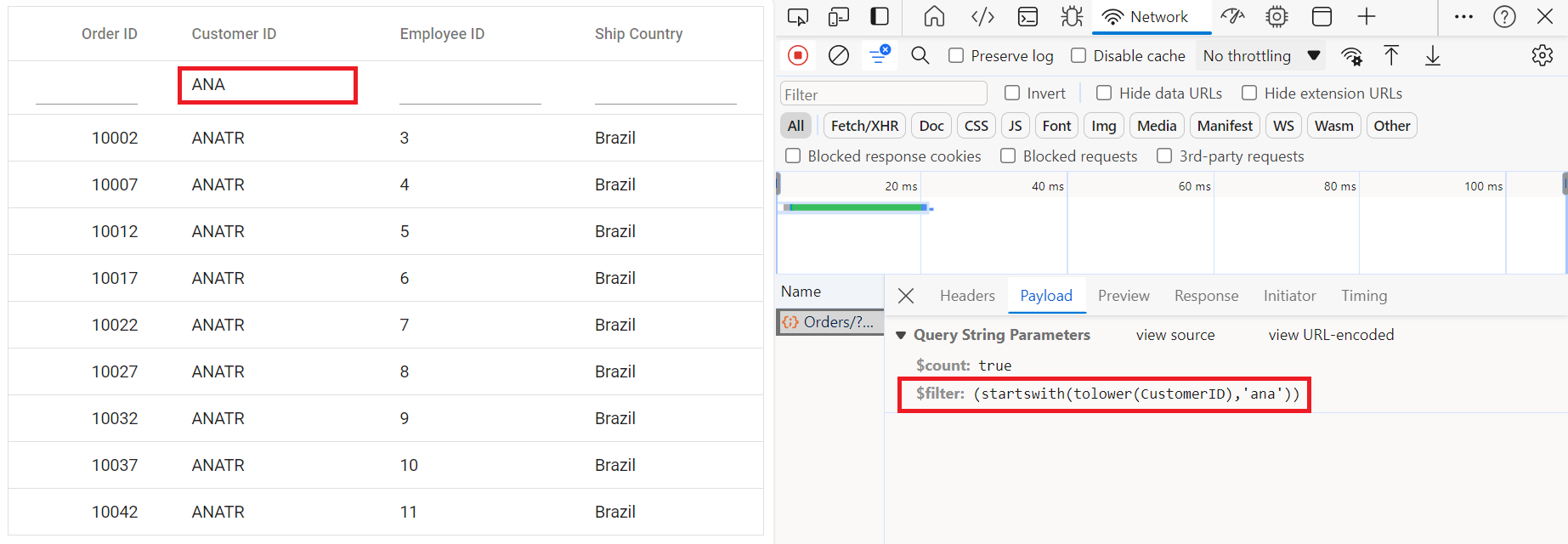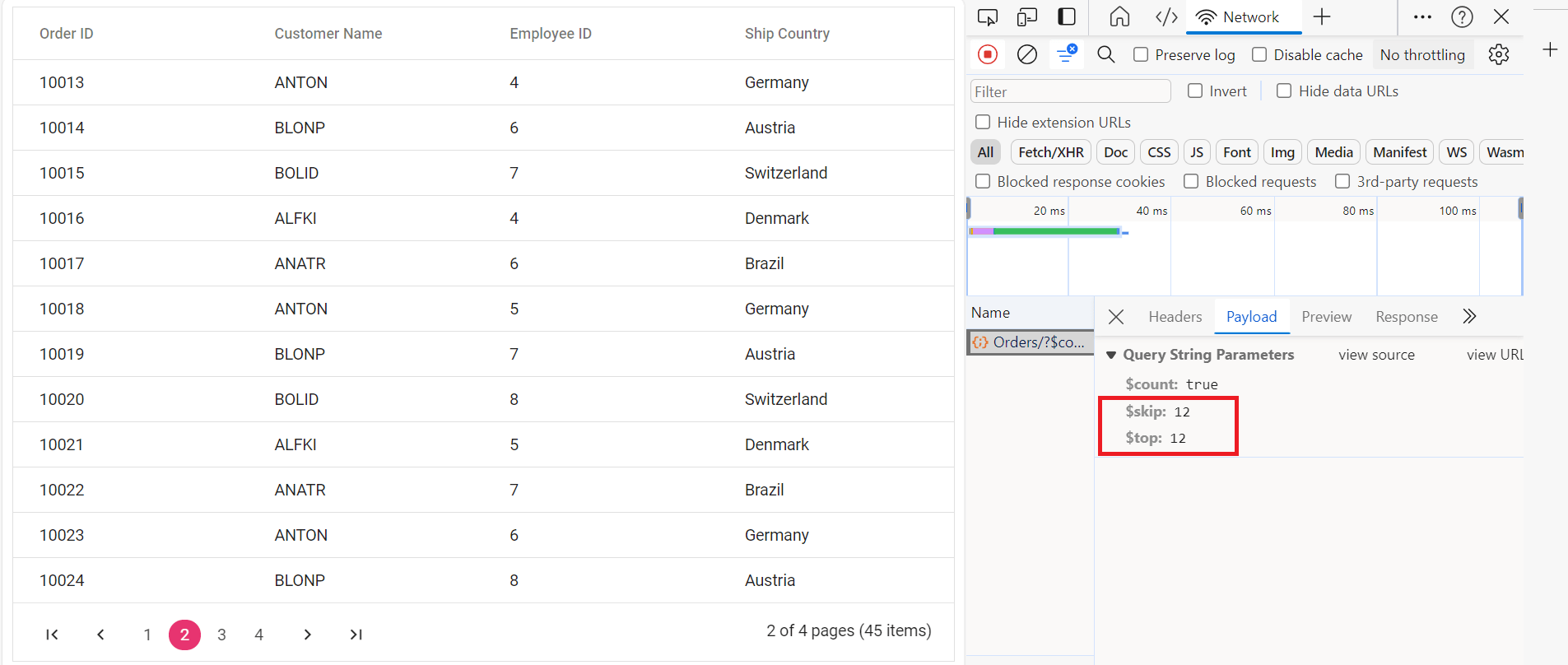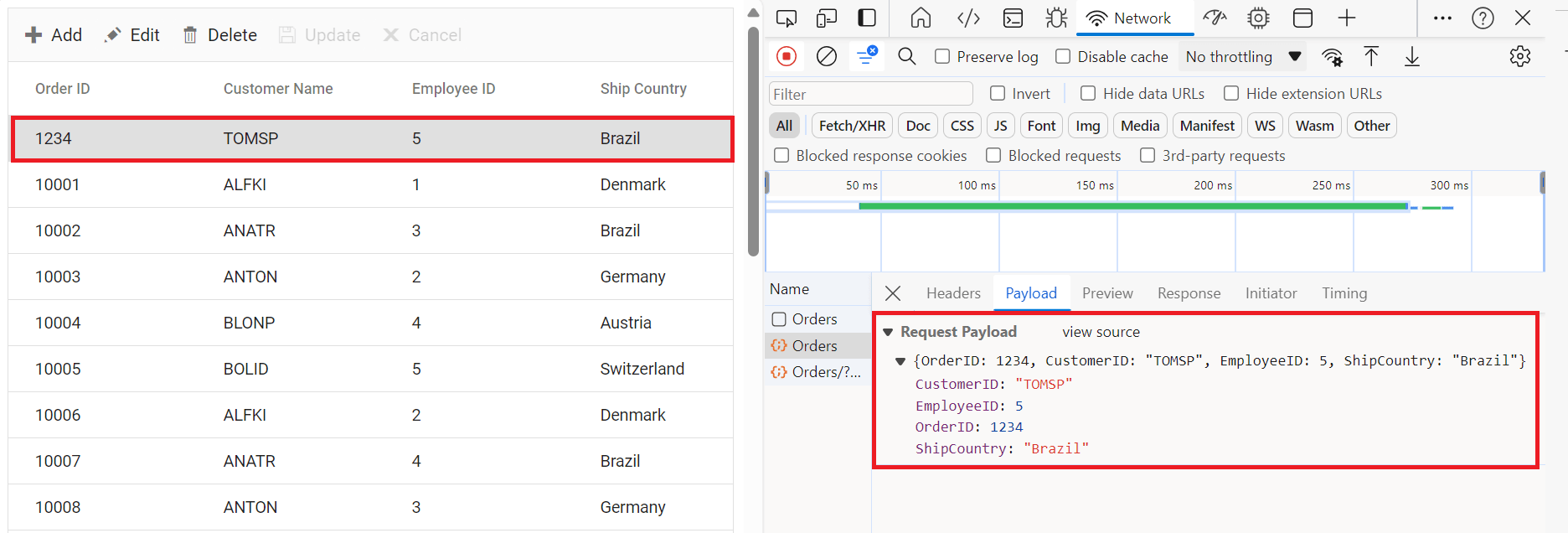ODataV4Adaptor in Syncfusion ASP.NET MVC Grid
20 Mar 202524 minutes to read
The ODataV4Adaptor in the Syncfusion ASP.NET MVC Grid allows seamless integration of the Syncfusion Grid with OData v4 services, enabling efficient data fetching and manipulation. This guide provides detailed instructions on binding data and performing CRUD (Create, Read, Update, Delete) actions using the ODataV4Adaptor in your Syncfusion ASP.NET MVC Grid.
Creating an OData Service
To configure a server with Syncfusion ASP.NET MVC Grid using OData, follow these steps:
1. Project Creation
- Open Visual Studio.
- Select Create a new project → Choose ASP.NET Web Application (.NET Framework).
- Name the project ODataV4Adaptor and select MVC as the project template.
- Ensure that the Web API option is selected.
For detailed information, refer to this documentation.
2. Install NuGet Packages
Using the NuGet package manager in Visual Studio (Tools → NuGet Package Manager → Manage NuGet Packages for Solution), install the Microsoft.AspNet.OData NuGet package for OData support and Newtonsoft.Json for JSON serialization support.
3. Model Class Creation:
Create a model class named OrdersDetails.cs inside the Models folder.
namespace ODataV4Adaptor.Models
{
public class OrdersDetails
{
public static List<OrdersDetails> order = new List<OrdersDetails>();
public OrdersDetails()
{
}
public OrdersDetails(
int OrderID, string CustomerId, int EmployeeId, double Freight, bool Verified,
DateTime OrderDate, string ShipCity, string ShipName, string ShipCountry,
DateTime ShippedDate, string ShipAddress)
{
this.OrderID = OrderID;
this.CustomerID = CustomerId;
this.EmployeeID = EmployeeId;
this.Freight = Freight;
this.ShipCity = ShipCity;
this.Verified = Verified;
this.OrderDate = OrderDate;
this.ShipName = ShipName;
this.ShipCountry = ShipCountry;
this.ShippedDate = ShippedDate;
this.ShipAddress = ShipAddress;
}
public static List<OrdersDetails> GetAllRecords()
{
if (order.Count() == 0)
{
int code = 10000;
for (int i = 1; i < 10; i++)
{
order.Add(new OrdersDetails(code + 1, "ALFKI", i + 0, 2.3 * i, false, new DateTime(1991, 05, 15), "Berlin", "Simons bistro", "Denmark", new DateTime(1996, 7, 16), "Kirchgasse 6"));
order.Add(new OrdersDetails(code + 2, "ANATR", i + 2, 3.3 * i, true, new DateTime(1990, 04, 04), "Madrid", "Queen Cozinha", "Brazil", new DateTime(1996, 9, 11), "Avda. Azteca 123"));
order.Add(new OrdersDetails(code + 3, "ANTON", i + 1, 4.3 * i, true, new DateTime(1957, 11, 30), "Cholchester", "Frankenversand", "Germany", new DateTime(1996, 10, 7), "Carrera 52 con Ave. Bolívar #65-98 Llano Largo"));
order.Add(new OrdersDetails(code + 4, "BLONP", i + 3, 5.3 * i, false, new DateTime(1930, 10, 22), "Marseille", "Ernst Handel", "Austria", new DateTime(1996, 12, 30), "Magazinweg 7"));
order.Add(new OrdersDetails(code + 5, "BOLID", i + 4, 6.3 * i, true, new DateTime(1953, 02, 18), "Tsawassen", "Hanari Carnes", "Switzerland", new DateTime(1997, 12, 3), "1029 - 12th Ave. S."));
code += 5;
}
}
return order;
}
[Key]
public int OrderID { get; set; }
public string CustomerID { get; set; }
public int? EmployeeID { get; set; }
public double Freight { get; set; }
public string ShipCity { get; set; }
public bool Verified { get; set; }
public DateTime OrderDate { get; set; }
public string ShipName { get; set; }
public string ShipCountry { get; set; }
public DateTime ShippedDate { get; set; }
public string ShipAddress { get; set; }
}
}4. Build the Entity Data Model
To construct the Entity Data Model for your OData service, utilize the ODataConventionModelBuilder to define the model’s structure. Start by creating an instance of the ODataConventionModelBuilder, then register the entity set Orders using the EntitySet<T> method, where OrdersDetails represents the CLR type containing order details.
private static IEdmModel GetEdmModel()
{
var builder = new ODataConventionModelBuilder();
builder.EntitySet<OrdersDetails>("Orders"); // Define OData Entity.
return builder.GetEdmModel();
}5. Register the OData Services
Once the Entity Data Model is built, you need to register the OData services in your ASP.NET MVC application. Here’s how:
// WebApiConfig.cs
using Microsoft.AspNet.OData.Builder;
using Microsoft.AspNet.OData.Extensions;
using Microsoft.OData.Edm;
using ODataV4Adaptor.Models;
using System;
using System.Collections.Generic;
using System.Linq;
using System.Web;
using System.Web.Http;
using System.Web.UI.WebControls;
namespace ODataV4Adaptor.App_Start
{
public static class WebApiConfig
{
public static void Register(HttpConfiguration config)
{
// Enable OData.
config.MapODataServiceRoute(
routeName: "ODataRoute",
routePrefix: "odata",
model: GetEdmModel()
);
// Enable Query Support.
config.Count().Filter().OrderBy().Expand().Select().MaxTop(null);
// Web API routes.
config.Routes.MapHttpRoute(
name: "DefaultApi",
routeTemplate: "api/{controller}/{action}/{id}",
defaults: new { id = System.Web.Http.RouteParameter.Optional }
);
// Configure JSON formatting.
config.Formatters.JsonFormatter.SerializerSettings.Formatting = Newtonsoft.Json.Formatting.Indented;
}
private static IEdmModel GetEdmModel()
{
var builder = new ODataConventionModelBuilder();
builder.EntitySet<OrdersDetails>("Orders"); // Define OData Entity.
return builder.GetEdmModel();
}
}
}5. Add Controllers
Create a controllers to expose the OData endpoints.
using System.Linq;
using Microsoft.AspNet.OData;
using System.Web.Http;
using ODataV4Adaptor.Models;
namespace ODataV4Adaptor.Controllers
{
public class OrdersController : ODataController
{
/// <summary>
/// Retrieves all orders.
/// </summary>
/// <returns>The collection of orders.</returns>
[EnableQuery]
public IHttpActionResult Get()
{
var data = OrdersDetails.GetAllRecords().AsQueryable();
return Ok(data);
}
}
}6. Run the Application
Run the application in Visual Studio. It will be accessible on a URL like https://localhost:xxxx.
After running the application, you can verify that the server-side API controller is successfully returning the order data in the URL(https://localhost:xxxx/odata/Orders). Here xxxx denotes the port number.
Connecting Syncfusion ASP.NET MVC Grid to an API service
To integrate the Syncfusion Grid into your ASP.NET MVC project using Visual Studio, follow these steps:
Step 1: Install the Syncfusion ASP.NET MVC Package:
To add ASP.NET MVC controls to your application, open the NuGet Package Manager in Visual Studio (Tools → NuGet Package Manager → Manage NuGet Packages for Solution), search for Syncfusion.EJ2.MVC5 and then install it. Alternatively, you can install it using the following Package Manager Console command:
Install-Package Syncfusion.EJ2.MVC5 -Version 32.1.19Step 2: Add Syncfusion ASP.NET MVC namespace
Add Syncfusion.EJ2 namespace reference in Web.config under Views folder.
<namespaces>
<add namespace="Syncfusion.EJ2"/>
</namespaces>Step 3: Add stylesheet and script resources
To include the required styles and scripts, add the following references inside the <head> of ~/Pages/Shared/_Layout.cshtml file:
<head>
...
<!-- Syncfusion ASP.NET MVC controls styles -->
<link rel="stylesheet" href="https://cdn.syncfusion.com/ej2/32.1.19/bootstrap5.css" />
<!-- Syncfusion ASP.NET MVC controls scripts -->
<script src="https://cdn.syncfusion.com/ej2/32.1.19/dist/ej2.min.js"></script>
<!-- Include the necessary CSS files to style the Syncfusion ASP.NET MVC component: -->
<link href="https://cdn.syncfusion.com/ej2/32.1.19/ej2-base/styles/bootstrap5.css" rel="stylesheet" />
<link href="https://cdn.syncfusion.com/ej2/32.1.19/ej2-grids/styles/bootstrap5.css" rel="stylesheet" />
<link href="https://cdn.syncfusion.com/ej2/32.1.19/ej2-buttons/styles/bootstrap5.css" rel="stylesheet" />
<link href="https://cdn.syncfusion.com/ej2/32.1.19/ej2-popups/styles/bootstrap5.css" rel="stylesheet" />
<link href="https://cdn.syncfusion.com/ej2/32.1.19/ej2-richtexteditor/styles/bootstrap5.css" rel="stylesheet" />
<link href="https://cdn.syncfusion.com/ej2/32.1.19/ej2-navigations/styles/bootstrap5.css" rel="stylesheet" />
<link href="https://cdn.syncfusion.com/ej2/32.1.19/ej2-dropdowns/styles/bootstrap5.css" rel="stylesheet" />
<link href="https://cdn.syncfusion.com/ej2/32.1.19/ej2-lists/styles/bootstrap5.css" rel="stylesheet" />
<link href="https://cdn.syncfusion.com/ej2/32.1.19/ej2-inputs/styles/bootstrap5.css" rel="stylesheet" />
<link href="https://cdn.syncfusion.com/ej2/32.1.19/ej2-calendars/styles/bootstrap5.css" rel="stylesheet" />
<link href="https://cdn.syncfusion.com/ej2/32.1.19/ej2-notifications/styles/bootstrap5.css" rel="stylesheet" />
<link href="https://cdn.syncfusion.com/ej2/32.1.19/ej2-splitbuttons/styles/bootstrap5.css" rel="stylesheet" />
<script src="https://cdnjs.cloudflare.com/ajax/libs/systemjs/0.19.38/system.js"></script>
<script src="https://cdn.syncfusion.com/ej2/syncfusion-helper.js" type="text/javascript"></script>
</head>Step 4: Register Syncfusion Script Manager
To ensure proper script execution, register the Syncfusion Script Manager EJS().ScriptManager() at the end of <body> in the ~/Views/Shared/_Layout.cshtml file as follows.
<body>
<!-- Syncfusion ASP.NET MVC Script Manager -->
@Html.EJS().ScriptManager()
</body>Step 5: Add the Syncfusion ASP.NET MVC Grid
Now, add the Syncfusion ASP.NET MVC Grid in ~/Views/Home/Index.cshtml file.
@using Syncfusion.EJ2
// Replace `xxxx` with your actual localhost port number.
@Html.EJS().Grid("Grid").DataSource(dm => dm.Url("https://localhost:xxxx/odata/orders").Adaptor("ODataV4Adaptor")).Columns(col =>
{
col.Field("OrderID").HeaderText("Order ID").Width("150").TextAlign(Syncfusion.EJ2.Grids.TextAlign.Right).IsPrimaryKey(true).Add();
col.Field("CustomerID").HeaderText("Customer ID").Width("150").Add();
col.Field("EmployeeID").HeaderText("Employee ID").Width("150").Add();
col.Field("ShipCountry").HeaderText("Ship Country").Width("150").Add();
}).Render()Step 7: Run the Project:
Run the project in Visual Studio, and the Syncfusion ASP.NET MVC Grid will successfully fetch data from the API service.
Replace https://localhost:xxxx/odata/Orders with the actual URL of your API endpoint that provides the data in a consumable format (e.g., JSON).
Handling Searching Operation
To enable search operations in your web application using OData, you first need to configure the OData support in your service collection. This involves adding the Filter method within the OData setup, allowing you to filter data based on specified criteria. Once enabled, clients can utilize the $filter query option in their requests to search for specific data entries.
...
// Enable OData.
config.MapODataServiceRoute(
routeName: "ODataRoute",
routePrefix: "odata",
model: GetEdmModel()
);
// Enable Query Support.
config.Count().Filter(); // Handles searching operation.
...// Replace `xxxx` with your actual localhost port number.
@Html.EJS().Grid("Grid").DataSource(ds => ds.Url("https://localhost:xxxx/odata/orders").Adaptor("ODataV4Adaptor")).Columns(col =>
{
col.Field("OrderID").HeaderText("Order ID").Width("150").TextAlign(Syncfusion.EJ2.Grids.TextAlign.Right).IsPrimaryKey(true).Add();
col.Field("CustomerID").HeaderText("Customer ID").Width("150").Add();
col.Field("EmployeeID").HeaderText("Employee ID").Width("150").Add();
col.Field("ShipCountry").HeaderText("Ship Country").Width("150").Add();
}).Toolbar(new List<string>() { "Search" }).Render()
Handling Filtering Operation
To enable filter operations in your web application using OData, you first need to configure the OData support in your service collection. This involves adding the Filter method within the OData setup, allowing you to filter data based on specified criteria. Once enabled, clients can utilize the $filter query option in your requests to filter for specific data entries.
...
// Enable OData.
config.MapODataServiceRoute(
routeName: "ODataRoute",
routePrefix: "odata",
model: GetEdmModel()
);
// Enable Query Support.
config.Count().Filter(); // Handles filtering operation.
...// Replace `xxxx` with your actual localhost port number.
@Html.EJS().Grid("Grid").DataSource(ds => ds.Url("https://localhost:xxxx/odata/orders").Adaptor("ODataV4Adaptor")).Columns(col =>
{
col.Field("OrderID").HeaderText("Order ID").Width("150").TextAlign(Syncfusion.EJ2.Grids.TextAlign.Right).IsPrimaryKey(true).Add();
col.Field("CustomerID").HeaderText("Customer ID").Width("150").Add();
col.Field("EmployeeID").HeaderText("Employee ID").Width("150").Add();
col.Field("ShipCountry").HeaderText("Ship Country").Width("150").Add();
}).AllowFiltering().Render()Single column filtering

Multi column filtering

Handling Sorting Operation
To enable sorting operations in your web application using OData, you first need to configure the OData support in your service collection. This involves adding the OrderBy method within the OData setup, allowing you to sort data based on specified criteria. Once enabled, clients can utilize the $orderby query option in their requests to sort data entries according to desired attributes.
...
// Enable OData.
config.MapODataServiceRoute(
routeName: "ODataRoute",
routePrefix: "odata",
model: GetEdmModel()
);
// Enable Query Support.
config.Count().OrderBy(); // Handles sorting operation.
...// Replace `xxxx` with your actual localhost port number.
@Html.EJS().Grid("Grid").DataSource(ds => ds.Url("https://localhost:xxxx/odata/orders").Adaptor("ODataV4Adaptor")).Columns(col =>
{
col.Field("OrderID").HeaderText("Order ID").Width("150").TextAlign(Syncfusion.EJ2.Grids.TextAlign.Right).IsPrimaryKey(true).Add();
col.Field("CustomerID").HeaderText("Customer ID").Width("150").Add();
col.Field("EmployeeID").HeaderText("Employee ID").Width("150").Add();
col.Field("ShipCountry").HeaderText("Ship Country").Width("150").Add();
}).AllowSorting().Render()Single column sorting

Multi column sorting

Handling Paging Operation
To implement paging operations in your web application using OData, you can utilize the SetMaxTop method within your OData setup to limit the maximum number of records that can be returned per request. While you configure the maximum limit, clients can utilize the $skip and $top query options in their requests to specify the number of records to skip and the number of records to take, respectively.
....
// Enable OData.
config.MapODataServiceRoute(
routeName: "ODataRoute",
routePrefix: "odata",
model: GetEdmModel()
);
var recordCount= OrdersDetails.GetAllRecords().Count;
// Enable Query Support.
config.Count().MaxTop(recordCount); // Handles paging operation.
....// Replace `xxxx` with your actual localhost port number.
@Html.EJS().Grid("Grid").DataSource(ds => ds.Url("https://localhost:xxxx/odata/orders").Adaptor("ODataV4Adaptor")).Columns(col =>
{
col.Field("OrderID").HeaderText("Order ID").Width("150").TextAlign(Syncfusion.EJ2.Grids.TextAlign.Right).IsPrimaryKey(true).Add();
col.Field("CustomerID").HeaderText("Customer ID").Width("150").Add();
col.Field("EmployeeID").HeaderText("Employee ID").Width("150").Add();
col.Field("ShipCountry").HeaderText("Ship Country").Width("150").Add();
}).AllowPaging().Render()
Handling CRUD Operations
To manage CRUD (Create, Read, Update, Delete) operations using the ODataV4Adaptor, follow the provided guide for configuring the Syncfusion Grid for editing and utilize the sample implementation of the OrdersController in your server application. This controller handles HTTP requests for CRUD operations such as GET, POST, PATCH, and DELETE.
To enable CRUD operations in the Syncfusion ASP.NET MVC Grid, follow the below steps:
// Replace `xxxx` with your actual localhost port number.
@Html.EJS().Grid("Grid").DataSource(ds => ds.Url("https://localhost:xxxx/odata/orders").Adaptor("ODataV4Adaptor")).Columns(col =>
{
col.Field("OrderID").HeaderText("Order ID").Width("150").TextAlign(Syncfusion.EJ2.Grids.TextAlign.Right).IsPrimaryKey(true).Add();
col.Field("CustomerID").HeaderText("Customer ID").Width("150").Add();
col.Field("EmployeeID").HeaderText("Employee ID").Width("150").Add();
col.Field("ShipCountry").HeaderText("Ship Country").Width("150").Add();
}).EditSettings(edit => { edit.AllowAdding(true).AllowEditing(true).AllowDeleting(true).Mode(Syncfusion.EJ2.Grids.EditMode.Normal); }).Toolbar(new List<string>() { "Add", "Edit", "Delete", "Update", "Cancel" }).Render()Normal/Inline editing is the default edit mode for the Grid. To enable CRUD operations, ensure that the IsPrimaryKey property is set to true for a specific Grid column, ensuring that its value is unique.
Insert Record
To insert a new record into your Syncfusion Grid, you can utilize the HttpPost method in your server application. Below is a sample implementation of inserting a record using the OrdersController:
/// <summary>
/// Inserts a new order to the collection.
/// </summary>
/// <param name="addRecord">The order to be inserted.</param>
/// <returns>It returns the newly inserted record detail.</returns>
[EnableQuery]
public IHttpActionResult Post(OrdersDetails addRecord)
{
if (addRecord == null)
{
return BadRequest("Null order");
}
OrdersDetails.GetAllRecords().Insert(0, addRecord);
return Ok(addRecord);
}
Update Operation:
Updating a record in the Syncfusion Grid can be achieved by utilizing the HttpPatch method in your controller. Here’s a sample implementation of updating a record:
/// <summary>
/// Updates an existing order.
/// </summary>
/// <param name="key">The ID of the order to update.</param>
/// <param name="updateRecord">The updated order details.</param>
/// <returns>It returns the updated order details.</returns>
public IHttpActionResult Patch(int key, OrdersDetails updateRecord)
{
if (updateRecord == null)
{
return BadRequest("No records");
}
var existingOrder = OrdersDetails.GetAllRecords().FirstOrDefault(order => order.OrderID == key);
if (existingOrder != null)
{
// If the order exists, update its properties.
existingOrder.CustomerID = updateRecord.CustomerID ?? existingOrder.CustomerID;
existingOrder.EmployeeID = updateRecord.EmployeeID ?? existingOrder.EmployeeID;
existingOrder.ShipCountry = updateRecord.ShipCountry ?? existingOrder.ShipCountry;
}
return Ok(existingOrder);
}
Delete Operation
To delete a record from your Syncfusion Grid, you can utilize the HttpDelete method in your controller. Below is a sample implementation:
/// <summary>
/// Deletes an order.
/// </summary>
/// <param name="key">The ID of the order to delete.</param>
/// <returns>It returns the deleted record detail.</returns>
public IHttpActionResult Delete(int key)
{
var deleteRecord = OrdersDetails.GetAllRecords().FirstOrDefault(order => order.OrderID == key);
if (deleteRecord != null)
{
OrdersDetails.GetAllRecords().Remove(deleteRecord);
}
return Ok(deleteRecord);
}
Odata with custom url
The Syncfusion ODataV4 adaptor extends support for calling customized URLs to accommodate data retrieval and CRUD actions as per your application’s requirements. However, when utilizing a custom URL with the ODataV4 adaptor, it’s essential to modify the routing configurations in your application’s route configuration file to align with your custom URL. You can invoke the custom URL by the following methods in the DataManager.
Configuring Custom URLs
To work with custom URLs for CRUD operations in the Syncfusion Grid, you can use the following properties:
- InsertUrl: Specifies the custom URL for inserting new records.
- RemoveUrl: Specifies the custom URL for deleting records.
- UpdateUrl: Specifies the custom URL for updating records.
- BatchUrl: Specifies the custom URL for batch editing operations.
Ensure that the routing configurations on the server-side are properly updated to handle these custom URLs.
The following code example describes the above behavior.
// Replace `xxxx` with your actual localhost port number.
@Html.EJS().Grid("Grid").DataSource(ds => ds.Url("https://localhost:xxxx/odata/orders").Adaptor("ODataV4Adaptor").InsertUrl(https://localhost:xxxx/odata/Orders/Insert).UpdateUrl(https://localhost:xxxx/odata/Orders/Update).RemoveUrl(https://localhost:xxxx/odata/Orders/Delete)).Columns(col =>
{
col.Field("OrderID").HeaderText("Order ID").Width("150").TextAlign(Syncfusion.EJ2.Grids.TextAlign.Right).IsPrimaryKey(true).Add();
col.Field("CustomerID").HeaderText("Customer ID").Width("150").Add();
col.Field("EmployeeID").HeaderText("Employee ID").Width("150").Add();
col.Field("ShipCountry").HeaderText("Ship Country").Width("150").Add();
}).EditSettings(edit => { edit.AllowAdding(true).AllowEditing(true).AllowDeleting(true).Mode(Syncfusion.EJ2.Grids.EditMode.Normal); }).Toolbar(new List<string>() { "Add", "Edit", "Delete", "Update", "Cancel" }).Render()For batch editing, you can specify a custom batch URL as follows:
// Replace `xxxx` with your actual localhost port number.
@Html.EJS().Grid("Grid").DataSource(ds => ds.Url("https://localhost:xxxx/odata/orders").Adaptor("ODataV4Adaptor").BatchUrl(https://localhost:xxxx/odata/Orders/BatchUpdate)).Columns(col =>
{
col.Field("OrderID").HeaderText("Order ID").Width("150").TextAlign(Syncfusion.EJ2.Grids.TextAlign.Right).IsPrimaryKey(true).Add();
col.Field("CustomerID").HeaderText("Customer ID").Width("150").Add();
col.Field("EmployeeID").HeaderText("Employee ID").Width("150").Add();
col.Field("ShipCountry").HeaderText("Ship Country").Width("150").Add();
}).EditSettings(edit => { edit.AllowAdding(true).AllowEditing(true).AllowDeleting(true).Mode(Syncfusion.EJ2.Grids.EditMode.Batch); }).Toolbar(new List<string>() { "Add", "Edit", "Delete", "Update", "Cancel" }).Render()